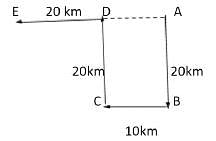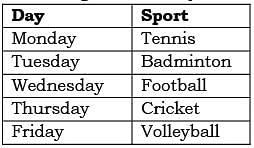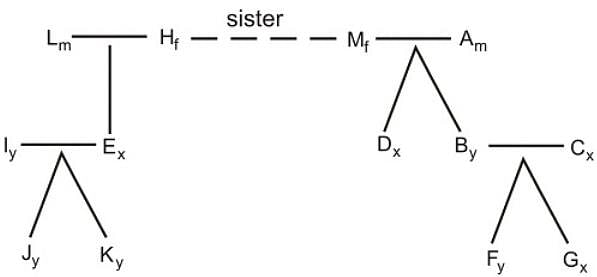APSC CCE Prelims (Paper 2) Mock Test - 7 - APSC CCE (Assam) MCQ
30 Questions MCQ Test - APSC CCE Prelims (Paper 2) Mock Test - 7
Direction: The total annual CO2 emissions from various sectors are 8 mm. In the Pie Chart given below, the percentage contribution to CO2 emissions from various sectors is indicated.
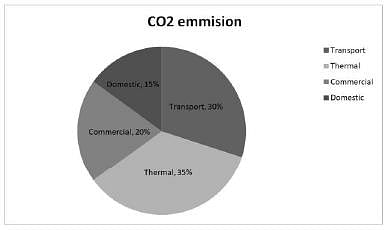
Q. Which of the following sectors together emit 4 mm of CO2 every year?

One day, Ravi left home and cycled 20 Km southwards, turned right and cycled 10 km and turned right and cycled 20 Km and turned left and cycled 20 Km. How many kilometres will he have to cycle to reach his home straight?
| 1 Crore+ students have signed up on EduRev. Have you? Download the App |
A, B and C have a few coins with them. 7 times the number of coins that A has is equal to 5 times the number of coins B has while 8 times the number of coins B has is equal to 13 times the number of coins C has. What is the minimum number of coins with A, B and C put together?
Directions for: Examine the information given in the following paragraph and answer the items there follow:
A school is celebrating Sport week in which five games viz. Cricket, Badminton, Tennis, Football and Volleyball are to be held in five different days in a week from Monday to Friday. Only one sport can be played on each day. Cricket cannot be played on Tuesday. Players for Badminton is available only on Tuesday. Volleyball is played immediately after the day of Cricket. Football has to played immediately before the day of Cricket.
Q. Which sport is scheduled between Tennis and Football?
Go through the following pie chart and answer the questions given below that.
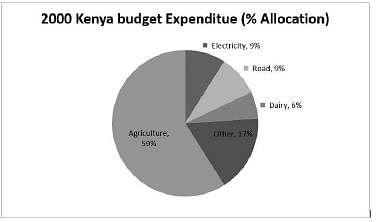
Q. Approximately how many degrees should be there in the central angle of the sector for agriculture expenditure?
Number of mobiles produced by Xiaomi Market share of bikes for year 2018
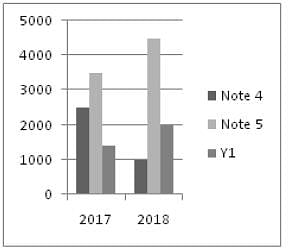
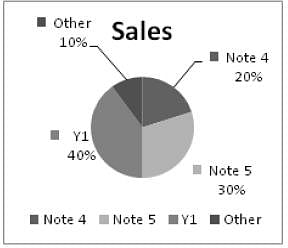
If in 2019 Galaxy 9 enters the market and is able to capture 5% of the 50,000 market then what is the percentage difference between market share of Galaxy 9 and Note 4? (Assuming percentage market share of Xiaomi mobiles and others is the same as in the previous year)
A class contains N students, having roll numbers 1,2,3....N. On a particular day only 50 students turn up for the class. The average of the roll numbers of the students present on that day is 38. A teacher punishes two students and sends them out of the class. The average of the roll numbers of the students who are left in the class drops to 37.5. Choose the correct statement from the options given below.
In a group of 20 children, two children have hundred marbles each and three do not possess any marbles. The average number of marbles with the rest of the children is 40. What is the average number of marbles with the group of children?
If a train travels at 60 km/hr from Bangalore to Hyderabad and at 80 km/hr on return trip from Hyderabad to Bangalore. What is its average speed for the entire trip?
Direction: The Fourth Industrial Revolution (IR) has the transformational power to unlock economic value that was previously inaccessible, by decoding nature’s DNA and by learning from its functions and processes. If the dividends are shared equitably, an inclusive bioeconomy could be created that provides a significant new funding stream for environmental conservation efforts.
Q. Which of the following is most rational inference from the above passage?
Direction: The total annual CO2 emissions from various sectors are 8 mm. In the Pie Chart given below, the percentage contribution to CO2 emissions from various sectors is indicated.

Q. Which of the following sectors have emission difference of 0.8 mm between them?
Number of mobiles produced by Xiaomi Market share of bikes for year 2018
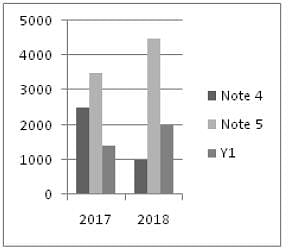

If Xiaomi Company wants all its Y1 which are produced in 2017 and 2018 to be sold then what should have been the number of Y1 produced in 2018?
Two, trains, one from Mumbai to New Delhi and the other from New Delhi to Mumbai, start simultaneously. After they meet, the trains reach their destinations after 9 hours and 16 hours respectively. What is the ratio of their speed?
Read the information given below carefully and answer the following question.
Theorists are divided concerning the origin of the Moon. Some hypothesize that the Moon was formed in the same way as were the planets in the inner solar system (Mercury, Venus, Mars, and Earth)—from planet-forming materials in the presolar nebula. But, unlike the cores of the inner planets, the Moon’s core contains little or no iron, while the typical planet-forming materials were quite rich in iron. Other theorists propose that the Moon was ripped out of the Earth’s rocky mantle by the Earth’s collision with another large celestial body after much of the Earth’s iron fell to its core. One problem with the collision hypothesis is the question of how a satellite formed in this way could have settled into the nearly circular orbit that the Moon has today. Fortunately, the collision hypothesis is testable. If it is true, the mantle rocks of the Moon and the Earth should be the same geochemically.
Q. According to the passage, Mars and the Earth are similar in which of the following ways?
1. Their satellites were formed by collisions with other celestial bodies.
2. Their cores contain iron.
3. They were formed from the presolar nebula.
At 5'O clock, clock ticks 5 times. The time between first and last tick was 36 sec. How much time it takes at 11'O clock?
Direction: Despite a recent acceleration of global economic activity, potential output growth is flagging. At 2.5 percent in 2013-17, post-crisis potential growth is below its longer-term average with an even steeper decline in emerging market and developing economies. This slowdown is evidence of slowing productivity growth and demographic trends that dampen labour supply growth.
Q. Which among the following is the most logical, rational and critical inference that can be made from the above passage?
A and B enter into a partnership and A invests
Rs. 15,000 in the partnership. At the end of 3 months, he withdraws Rs.5000. At the end of another 5 months, he withdraws another Rs.5000. If B receives Rs. 12,000 as his share of the total profit of Rs. 23,500 for the year, how much did B invest in the company?
Directions for the following (one) item:
Read the following passage and answer the item that follow. Your answer to this item should be based on the passage only.
Health accessibility and affordability remain a crucial healthcare problem even in the 21st century. Therefore the World Health Organisation chose "Universal Health Coverage" as the theme for World Health Day 2019. India started working towards the universal problem of affordability and accessibility with the introduction of Ayushman Bharat. The scheme gave a family cover of Rs. 5 lac to socio-economically weaker section and roped it many private sector hospitals to deliver the services. Sadly, most of the roped in hospitals are situated in the urban localities and last mile accessibility remains a point of concern in the country with diverse cultures and topography.
Q. Which is the most critical and rational inference that can be made from the above passage?
Directions: In the following question assuming the given statements to be True, find which of the conclusion among given conclusions is/are definitely true and then give your answers accordingly.
Statements:
A > B, B > C, C = D, D < E
Conclusions:
I. B = D
II. B > D
Directions: Study the information given below and answer the question that follows.
A is the father of two children, B and D, who are of different sexes.
C is B's spouse.
E is of the same sex as D.
B and C have two children: F, who is of the same sex as B and G, who is of the same sex as C.
E's mother H, who is married to L, is the sister of D's mother, M.
E and E's spouse, I, have two children J and K, who are of the same sex as I.
No person has married more than once, and no children have been born out of wedlock.
The only restriction on marriage is that marriage to a sibling, to a direct descendant, or to more than one person at the same time is forbidden.
Q. According to the rules, D can marry
Road the passage given below and the two statements that follow (given on the basis of the passage);
Four athletes are waiting at Beijing airport for a Mumbai flight. Two are Sprinters and the other two are Badminton players. Two are from Maharashtra and two are from Bengal. No two of the same profession are from the same state. Two are Muslims and two are Christian. No two of the same religion are of the same profession nor do they are from the same state, The Bengal’s Sprinter is a Christian.
1. The Christian-Badminton player is from Maharashtra.
2. The Maharashtra’s Sprinter is a Muslim.
Q. Which of the above statement(s) is/are correct conclusion(s)?
The table represent the percentage expenditure of the income of A, B, C, D, E and F on different items.
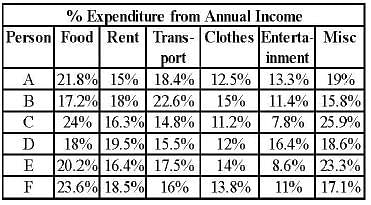
The percentage of amount of money spent by E on entertainment is what percentage of the amount of money spent by F on transport?
Direction: Study the following information and answer the questions that follow:
Five guest lecturers have to be scheduled for students starting from Monday and ending on Friday of the same week. The topics of lectures are maths, science, language, civics, and grooming, not necessarily in the same order. The experts for lectures belong to Hyderabad, Chennai, Mumbai, Delhi, and Jaipur, not necessarily in the same order. Three guest lecturers are females and two are males.
The males will take lectures on alternate days and won't be available on Monday. The expert who belongs to Delhi is a female and is free only on Tuesday. The Civics lecture needs to be scheduled on Wednesday. Neither grooming nor maths can be scheduled for Monday. The language lecture should be scheduled after civics. The grooming expert belongs to Hyderabad. The expert of science neither belongs to Chennai, nor to Jaipur. A female expert belongs to Jaipur.
Q.
The Civics lecture was delivered by an expert from which of the following day?
A man travels a distance of 12 km at 3 km/hr, another distance of 12km at 4 km/hr and a third distance of 12km at 6 km/hr. His average speed for the whole journey is:
The following piechart shows the percentage distribution of the expenditure incurred in publishing a book. Study the pie-chart and the answer the questions based on it. Various Expenditures (in percentage) Incurred in Publishing a Book.
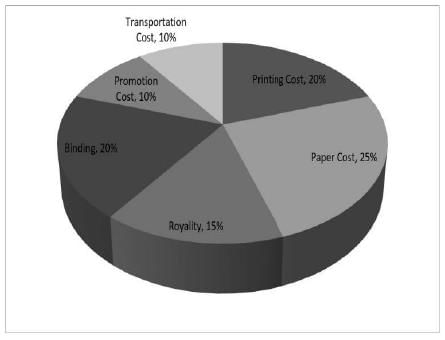
If 5500 copies are published and the transportation cost on them amounts to Rs. 82500, then what should be the selling price of the book so that the publisher can earn a profit of 25%?
Go through the following pie chart and answer the questions given below that.

If Rs. 9mn were spent in 2000 on Dairy, what would have been the total expenses in that year in million?
How many really suffer as a result of labour market problems? This is one of the most critical yet contentious social policy questions. In many ways, our social statistics exaggerate the degree of hardship. Unemployment does not have the same dire consequences today as it did in the 1930‘s when most of the unemployed were primary breadwinners, when income and earnings were usually much closer to the margin of subsistence, and when there were no countervailing social programs for those failing in the labour market. Increasing affluence, the rise of families with more than one wage earner, the growing predominance of secondary earners among the unemployed, and improved social welfare protection have unquestionably mitigated the consequences of joblessness. Earnings and income data also overstate the dimensions of hardship. Among the millions with hourly earnings at or below the minimum wage level, the overwhelming majority are from multiple- earner, relatively affluent families. Most of those counted by the poverty statistics are elderly or handicapped or have family responsibilities which keep them out of the labour force, so the poverty statistics are by no means an accurate indicator of labour market pathologies.
Which of the following is the principal topic of the passage?
If x = 2 is a root of the quadratic equation 3x2 – px – 2 = 0, then the value of ‘p’ is
If = stands for ÷; + stands for -; - stands for +; × stands for =; ÷ stands for ×; which of the following is true?
Tina goes to school from her house at a speed of 3 km/hr and returns at a speed of 2 km/hr. If she takes 5 hours in total, then what is the distance between her house and school?


